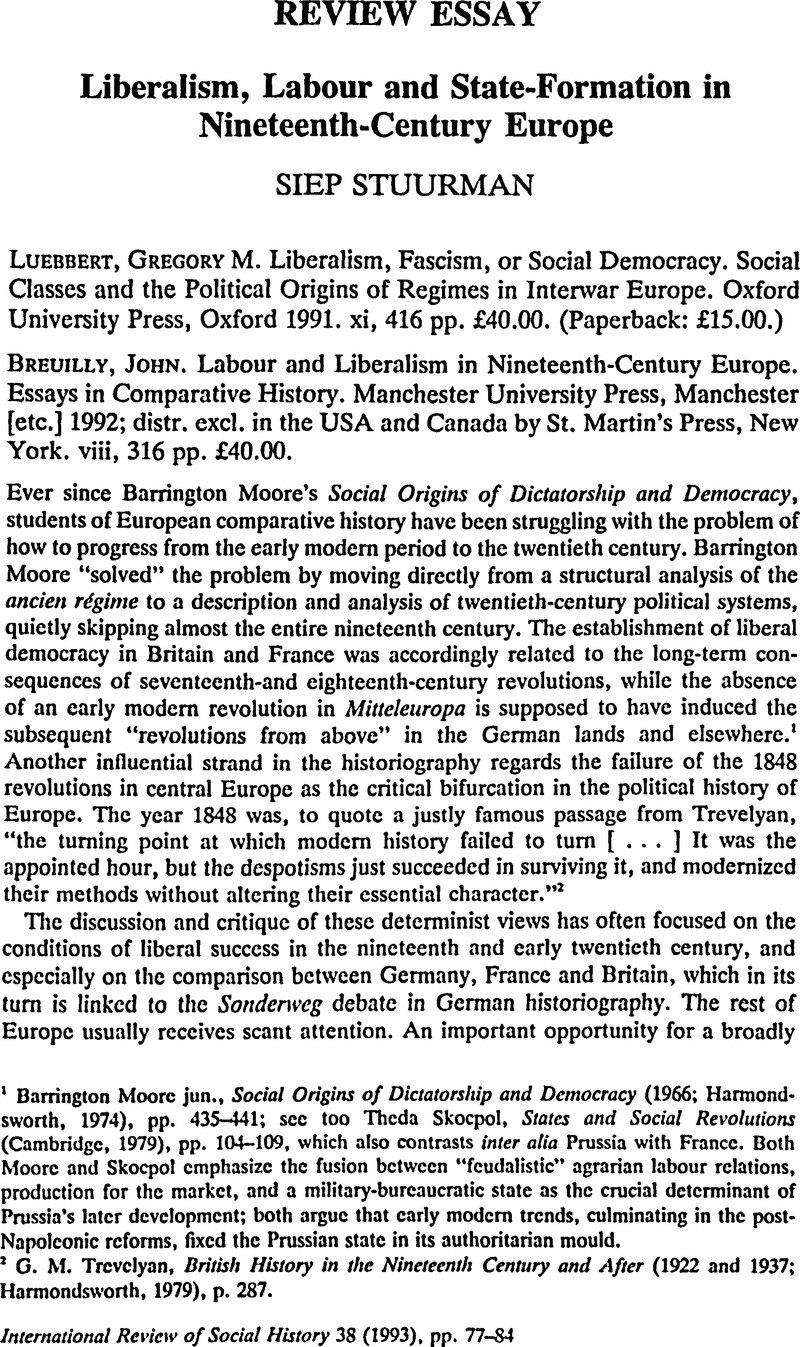Published online by Cambridge University Press: 20 February 2009

1 Moore, Harrington Jun, Social Origins of Dictatorship and Democracy (1966; Harmond-sworth, 1974), pp. 435–441Google Scholar; sec too Skocpol, Theda, States and Social Revolutions (Cambridge, 1979), pp. 104–109CrossRefGoogle Scholar, which also contrasts inter alia Prussia with France. Both Moore and Skocpol emphasize the fusion between “feudalistic” agrarian labour relations, production for the market, and a military-bureaucratic state as the crucial determinant of Prussia's later development; both argue that early modern trends, culminating in the post-Napoleonic reforms, fixed the Prussian state in its authoritarian mould.
2 Trevelyan, G. M., British History in the Nineteenth Century and After (1922 and 1937; Harmondsworth, 1979), p. 287.Google Scholar
3 Luebbert himself states that Belgium and the Netherlands “most closely approximated the British-French-Swiss pattern of liberal hegemony” (p. 56)Google Scholar. So why label them a-liberal?
4 Sperber, Jonathan, Rhineland Radicals: The Democratic Movement and the Revolution of 1848–1849 (Princeton, 1991), pp. 476ff.Google Scholar
5 See the detailed analysis in Siemann, Wolfram, Gesellschaft im Aufbruch: Deutschland 1849–1871 (Frankfurt-On-Main, 1990), pp. 200–231Google Scholar. Siemann stresses the fact that the decisive transformation of German liberalism occurred after 1866.
6 The importance of the latter point is underlined by Sheehan, James J., Der deutsche Liberalismus (Munich, 1983), pp. 216–217.Google Scholar
7 See Tilly, Charles, Coercion, Capital, and European States (Cambridge, Mass., and Oxford, 1991).Google Scholar
8 For an elaboration of this point see Sewell, William H. Jun., “Collective Violence and Collective Loyalties in France: Why the French Revolution Made a Difference”, Politics and Society, 18 (1990), pp. 527–552.CrossRefGoogle Scholar
9 A similar argument is made by Eisenberg, Christiane, “The Comparative View in Labour History”, International Review of Social History, 34 (1989), pp. 403–432CrossRefGoogle Scholar, csp. pp. 427–428.
10 See also Lenger, Friedrich, “Beyond Exceptionalism: Notes on the Artisanal Phase of the Labour Movement in France, England, Germany and the United States”, International Review of Social History, 36 (1991), pp. 1–23.CrossRefGoogle Scholar
11 The vital importance of this aspect of British liberal politics is highlighted in a recent study by Biagini, Eugenio F., Liberty, Retrenchment and Reform: Popular Liberalism in the Age of Gladstone. 1860–1880 (Cambridge, 1992).Google Scholar
12 This is the main thrust of Blackboum, David and Eley, Geoff's argument in The Peculiarities of German History: Bourgeois Society and Politics in Nineteenth-Century Germany (Oxford, 1984).CrossRefGoogle Scholar